For running a business safely and securely in the cloud, you have to comply with a certain set of rules. This set of rules or policies that govern your business in the cloud environment are referred to as cloud governance. Typically, these policies share many similarities with those governing on-premise IT infrastructures.
These rules are focused on enhancing privacy, data security, and managing risks in order to secure the data and ensure the smooth operation of the application. In addition to enhancing and optimizing security and efficiency, cloud governance best practices also help economize a business’ finances by allowing it to do more with less usage of resources.
Is Changing Your Current Governance Strategy Necessary?
Since every IT business has governance protocols and strategies, you might be wondering: why must I change my existing governance framework? Is it inadequate to handle problems raised by shifting to a cloud environment?
Well, the shorter version of that answer is, Yes. That is because the traditional IT governance framework is based on using centralized tools custom-made for workers of specific departments. Although this approach is best suited for centralized tools, the cloud environment and its operations by nature are decentralized.
A cloud governance strategy allows for creating a standardized policy that can be followed by various employees and departments of the business irrespective of their roles or subdivisions.
This strategy enables every employee to share and be on an equal footing while working in the cloud environment. The cloud, like enterprise infrastructure, needs bodies that govern its environment and standardize its services and other shared infrastructure issues.
Five Pillars of Cloud Governance
The efficiency of cloud installation is definitely dependent upon the organization’s systems and procedures. However, they also impact the structure of their platform and its underlying architecture. Based on the following five pillars, one can effectively implement designs that ensure scalability.
Operational Excellence
This pillar focuses on your workload operating as desired, monitoring every process and system to yield higher business value and continuously improve them. To ensure that your workload runs effectively with governance principles, operations will have to be performed as per code, incremental development of applications, and continuous refinement of processes involved.
Reliability
Reliability focuses on ensuring that your application performs as desired and that it does so continually without encountering a complete failure. Even the most reliable applications encounter failures, but they can recover quickly to meet customer demand. This is because their workloads are distributed, and the only resources they utilize are the ones that are required for production workloads.
Performance Efficiency
Performance efficiency is all about using technical resources efficiently for increasing business returns and operational efficiency. An example of such can be the usage of serverless platforms for app deployment. You can also deploy your workload across a vast region so customers accessing it globally can experience quicker interaction.
Security
This fourth pillar focuses on protecting the confidential information, data, and systems of your business. It urges you to secure your applications by implementing strong identification protocols and access controls
Cost Optimization
The last focuses on optimizing and reducing the operational and up-front costs of cloud development for your business, along with a monitored and streamlined usage of resources. It recommends that you focus on core development activities while outsourcing all the ancillary services to a third-party vendor to reduce the time taken for development and corresponding costs.
To learn more about each pillar in detail, download our whitepaper here.
Cloud Security Governance Challenges
Following are some of the practical use cases of cloud governance strategies and how they help tackle governance challenges.
Safeguarding Against Eventualities
When a business avails cloud services from a vendor, it is the responsibility of the service provider to provide continuous and reliable services. It is also their responsibility to enhance said services. If the vendor’s service goes down, so will be the performance of the client. Having a proper cloud governance model in place helps avoid such situations.
Cost-Effectiveness
Cloud development is an extremely cost-effective approach to application making, and with the right governance policies in place, the business can reap huge profits. A well-optimized cloud governance model can run far more efficient financial analytics and yield an optimal way of automating these policies. It can also retain management reporting to help with cost management.
Data Security
Securing your data is one of the top priorities of any IT business, and a well-planned cloud strategy can secure you against hackers exploiting loopholes. Cloud governance policies and best practices dictate that you build a robust authenticating system to safeguard your confidential information. The reason behind such a strict rule is that cloud service providers such as AWS have many inherent security bugs.
At GoDgtl, we help businesses establish robust cloud governance frameworks for hybrid, cloud, and multi-cloud environments, enabling companies to maintain compliance, democratize data, and support collaboration.
Get in touch with our data modernization team to learn more about how we can help your company build a solid data governance framework.
Recent Posts
Let's Talk
Our GoDgtl team is ready to help you!
We appreciate your interest in GoDgtl. Please select which team of experts you wish to engage:
